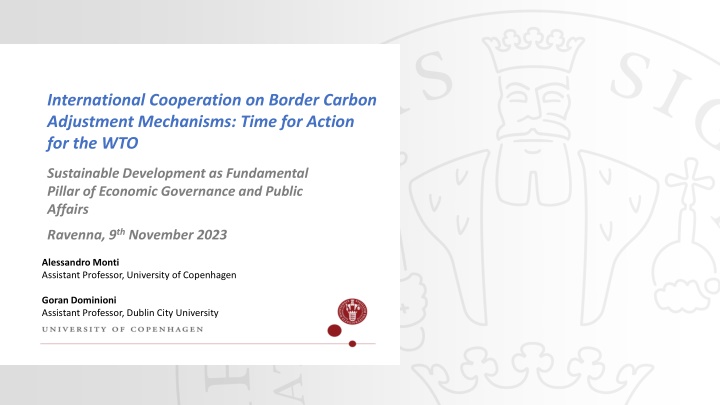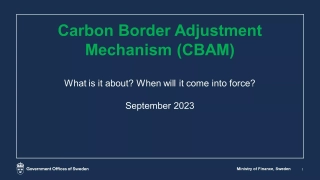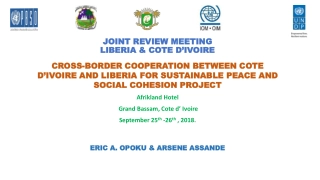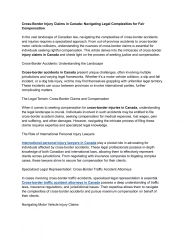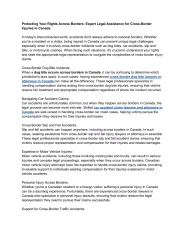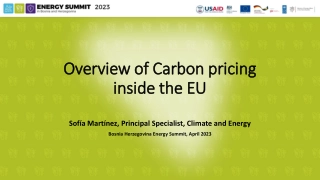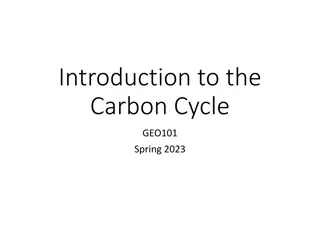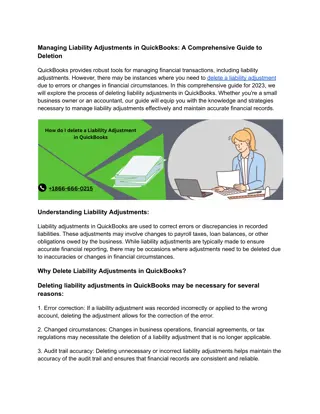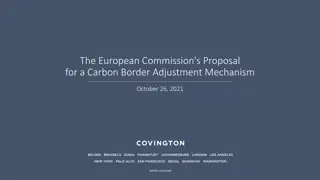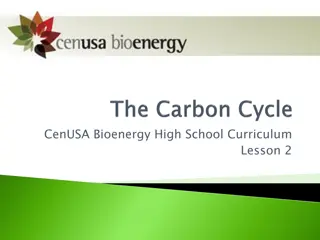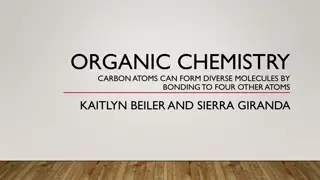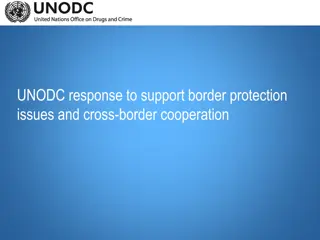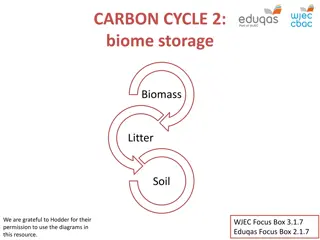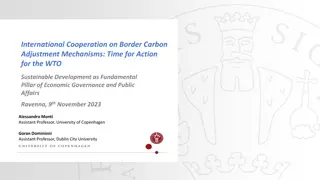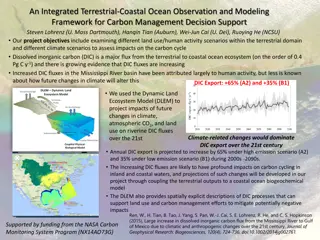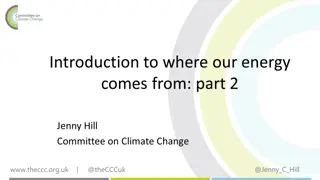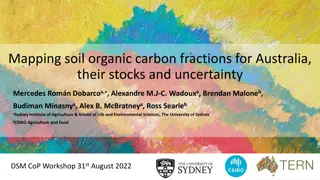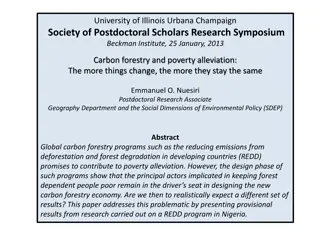International Cooperation on Border Carbon Adjustment Mechanisms: Time for Action for the WTO
This event, scheduled for November 9th, 2023 in Ravenna, focuses on the importance of global collaboration in establishing border carbon adjustment mechanisms. Assistant Professors Alessandro Monti and Goran Dominioni will provide insights on the significance of sustainable development in economic governance and public affairs.
Download Presentation

Please find below an Image/Link to download the presentation.
The content on the website is provided AS IS for your information and personal use only. It may not be sold, licensed, or shared on other websites without obtaining consent from the author.If you encounter any issues during the download, it is possible that the publisher has removed the file from their server.
You are allowed to download the files provided on this website for personal or commercial use, subject to the condition that they are used lawfully. All files are the property of their respective owners.
The content on the website is provided AS IS for your information and personal use only. It may not be sold, licensed, or shared on other websites without obtaining consent from the author.
E N D
Presentation Transcript
International Cooperation on Border Carbon Adjustment Mechanisms: Time for Action for the WTO Sustainable Development as Fundamental Pillar of Economic Governance and Public Affairs Ravenna, 9thNovember 2023 Alessandro Monti Assistant Professor, University of Copenhagen Goran Dominioni Assistant Professor, Dublin City University
Embedded emissions in international trade Around 22% of global CO2 emissions are embedded in imported goods i.e. are debited to the exporting country Increase of carbon leakage as production continues to shift to countries with lower climate ambition or less-regulated countries Countries may meet their Paris Agreement targets while emissions abroad increase due to consumption of imported products Source: Hasanbeigi et al., 2022 2
Cooperation in the Climate and Trade regimes Lack of provisions on trade in the Paris Agreement however openness as general principle under Art 3.5 UNFCCC Sustainable development as a general principle in the WTO Agreement Increased focus on climate change in new generation FTAs e.g. obligation to maintain carbon pricing systems under the EU-UK TCA (Art 392) Yet, bilateral cooperation has its limits. Still crucial role for multilateral cooperation on climate and trade 3
Multilateral cooperation on climate and trade WTO institutions and initiatives o Committee on Trade and Environment (CTE) o Trade and Environmental Sustainability Structured Discussions (TESS-D) o Fossil Fuel Subsidy Reform initiative (FFSR) o Trade day at COP 28 Other multilateral initiatives o Coalition of Trade Ministers on Climate (50+ members) o G7 Climate Club o OECD Inclusive Forum on Carbon Mitigation Approaches (IFCMA) 4
The case for carbon border adjustment mechanisms CBAM rationales o By charging a price on GHGs embedded in imported products, CBAMs can level the playing field between domestic and foreign producers selling in the importing country o Incentivize the uptake of more ambitious climate policies in trading partner countries to reduce compliance cost in export sectors e.g. energy efficiency policies, subsidies for green energy technologies, etc. o CBAMs can reduce leakage by more than one-third on average depending on design of the measure 5
The challenges of carbon border adjustment mechanisms CBAMs: WTO law challenges o Compliance issues with WTO law depending on design Internal regulation (Art III:4 GATT) or tax adjustment (Art III:2 GATT) Most-favoured-nation and crediting for policies abroad Article I GATT Possibility to justify under Article XX GATT? o Unilateralism increasing risk of trade disputes and retaliation 6
Design of carbon border adjustment mechanisms Design feature Suggestion Rationale(s) Focus on high carbon leakage risk Sectoral coverage Trade-exposed and carbon- intensive products Emission coverage Direct emissions perhaps also GHGs from energy use Reduces admin costs Benchmark emissions Firm-level benchmark per type of product Maintains incentives to decarbonize Avoids resource shifting CBDRRC Using carbon revenues, not exemptions Avoids trade distortions and slower uptake of greener technologies Helps compliance with WTO law Policies adjusted and credited Carbon taxes, emission allowance trading schemes and some implicit carbon prices (expansive list) Potentially greater environmental effectiveness Compliance with WTO law 7
EU CBAM and US Foreign Pollution Fee Act EU CBAM o Crediting only for explicit carbon pricing o Lack of specific provisions on use of revenues lack of indications that it will support climate mitigation and adaptation in developing countries U.S. Foreign Pollution Fee Act o Bill proposed in the U.S. Congress in November 2023 o Charges based on exporting countries GHG average for each covered product unless Facility Specific Agreement with Congress approval o Possibility to negotiate International Partnership Agreements with third countries to exclude charges if foreign products have GHG emissions <50% greater than US average and partner also eliminates charges on those goods 8
Cooperation with other multilateral institutions OECD, IMF, World Bank help with estimating carbon pricing equivalent of various GHG policies e.g. technical work under IFCMA to set methodologies for calculating sector- and product-level carbon intensity metrics ISO help set up a certification standard for GHG emissions embedded in producing the goods under the BCA mechanism UNCTAD provide a third-party assessment of the economic impacts of border carbon adjustment mechanisms 9
Benefits of international cooperation Ensure impartiality of GHG calculation methodologies Increase compliance of WTO law and reduce risk of disputes Promote transparency in design and implementation of CBAMs Achieve greater effectiveness of CBAMs for climate goals 10
Benefit of multilateral cooperation on CBAM for the WTO Reaffirm its central role in international trade relations Incorporate best practices on linking climate and trade considerations from bilateral trade agreements Pursue its mission on both trade and environment reduce trade distortions from uninternalized climate externalities while concretizing mutual supportiveness of climate and trade law 11
Thank you! Alessandro Monti Assistant Professor, University of Copenhagen Goran Dominioni Assistant Professor, Dublin City University
